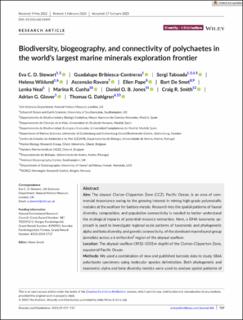| dc.contributor.author | Stewart, Eva C.D. | |
| dc.contributor.author | Bribiesca-Contreras, Guadalupe | |
| dc.contributor.author | Taboada, Sergi | |
| dc.contributor.author | Wiklund, Helena | |
| dc.contributor.author | Ravara, Ascensao | |
| dc.contributor.author | Pape, Ellen | |
| dc.contributor.author | De Smet, Bart | |
| dc.contributor.author | Neal, Lenka | |
| dc.contributor.author | Cunha, Marina R. | |
| dc.contributor.author | Jones, Daniel O.B. | |
| dc.contributor.author | Smith, Craig R. | |
| dc.contributor.author | Glover, Adrian G. | |
| dc.contributor.author | Dahlgren, Thomas Gunnar | |
| dc.date.accessioned | 2023-08-21T13:26:36Z | |
| dc.date.available | 2023-08-21T13:26:36Z | |
| dc.date.created | 2023-04-18T14:29:19Z | |
| dc.date.issued | 2023 | |
| dc.identifier.citation | Divesity and Distributions. 2023, 29 (6), 727-747. | en_US |
| dc.identifier.issn | 1472-4642 | |
| dc.identifier.uri | https://hdl.handle.net/11250/3085100 | |
| dc.description.abstract | Aim The abyssal Clarion-Clipperton Zone (CCZ), Pacific Ocean, is an area of commercial importance owing to the growing interest in mining high-grade polymetallic nodules at the seafloor for battery metals. Research into the spatial patterns of faunal diversity, composition, and population connectivity is needed to better understand the ecological impacts of potential resource extraction. Here, a DNA taxonomy approach is used to investigate regional-scale patterns of taxonomic and phylogenetic alpha and beta diversity, and genetic connectivity, of the dominant macrofaunal group (annelids) across a 6 million km2 region of the abyssal seafloor. Location The abyssal seafloor (3932–5055 m depth) of the Clarion-Clipperton Zone, equatorial Pacific Ocean. Methods We used a combination of new and published barcode data to study 1866 polychaete specimens using molecular species delimitation. Both phylogenetic and taxonomic alpha and beta diversity metrics were used to analyse spatial patterns of biodiversity. Connectivity analyses were based on haplotype distributions for a subset of the studied taxa. Results DNA taxonomy identified 291–314 polychaete species from the COI and 16S datasets respectively. Taxonomic and phylogenetic beta diversity between sites were relatively high and mostly explained by lineage turnover. Over half of pairwise comparisons were more phylogenetically distinct than expected based on their taxonomic diversity. Connectivity analyses in abundant, broadly distributed taxa suggest an absence of genetic structuring driven by geographical location. Main Conclusions Species diversity in abyssal Pacific polychaetes is high relative to other deep-sea regions. Results suggest that environmental filtering, where the environment selects against certain species, may play a significant role in regulating spatial patterns of biodiversity in the CCZ. A core group of widespread species have diverse haplotypes but are well connected over broad distances. Our data suggest that the high environmental and faunal heterogeneity of the CCZ should be considered in future policy decisions. | en_US |
| dc.language.iso | eng | en_US |
| dc.rights | Navngivelse 4.0 Internasjonal | * |
| dc.rights.uri | http://creativecommons.org/licenses/by/4.0/deed.no | * |
| dc.title | Biodiversity, biogeography, and connectivity of polychaetes in the world's largest marine minerals exploration frontier | en_US |
| dc.title.alternative | Biodiversity, biogeography, and connectivity of polychaetes in the world's largest marine minerals exploration frontier | en_US |
| dc.type | Journal article | en_US |
| dc.rights.holder | © 2023 The Authors | en_US |
| dc.description.version | publishedVersion | en_US |
| cristin.ispublished | true | |
| cristin.fulltext | original | |
| dc.identifier.doi | 10.1111/ddi.13690 | |
| dc.identifier.cristin | 2141640 | |
| dc.source.journal | Divesity and Distributions | en_US |
| dc.source.volume | 29 | en_US |
| dc.source.issue | 6 | en_US |
| dc.source.pagenumber | 727-747 | en_US |

